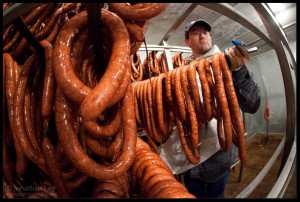The first Saturday of each November is time for the annual sausage dinner at Visitation Parish in Verboort Oregon. So what does this have to do with a photography blog? With all kinds of activities, people doing interesting things, and a good bit of historical context, there are plenty of opportunities for a little photojournalism.
Verboort, Oregon is a tiny hamlet, with a population probably not pusing 100. The sausage dinner is a fundraiser for the local Catholic parish/school, and now entering its 75th year, is also a certified tradition.

To make 13 tons of (and they have capacity for 20 tons!) of sausage, takes a lot of work from a lot of volunteers. The Saturday prior to the dinner, a call goes out for all hands. I decided to check it out this year to learn more about the event and just do something fun and rewarding. As for the photos? I wasn’t even sure if they’d allow me to take photos (some thoughts of a secret sausage factory entered my mind). I got to work at around 7am, and spent about 5 hours feeding “casings” (ok, they’re pig intestines… there, I said it.) onto metal rods so they’re primed & ready for the grinder, which forces the ground sausage into the casings (kind of like inflating a balloon). The sausage is then wheeled over to the smokehouse room, where its hung on racks and smoked over the next couple days.
Volunteering gave me the opportunity to learn a bit more about how the whole process works. It gave me time to walk around and see the operation, get to know some of the people involved, ask if I could take some photos, and think about what kinds of photos I wanted to take. One of the basics of photojournalism is simply to document the event… and that’s always my primary goal with these types of events; just get some basic shots that show what happened. If I’m able to work a little and improve the composition, lighting, or timing of the various shots, that’s just a bonus. So, I set to work just documenting each part of the process.
I started with my widest lens – a 15mm fisheye. I went methodically through each part of the process, and used this lens to do what I could. The 15mm fisheye can show a lot of activity all at once – perfect for a situation like this. But, the price to pay is the distortion of the lens. For photojournalistic shots with the 15mm fisheye, I tend to just ignore the distortion. Using non-standard angles (i.e. tilting the camera) can help make these distortions less apparent. If the horzontal and vertical lines are bent, they might as well be tilted too… hopefully the main subject of the image will be interesting enough to make the distortion less apparent.
After the fisheye, I worked my way toward longer focal lengths; 24-70mm, then 85mm. As I already had some “overview” shots with the fisheye, I could then focus on particular elements that added interesting details.

Very often, it takes a lot of shooting to get what I want. For example, one of the more difficult parts of the process to photograph was the job I spent 5 hours doing – loading the casings on the metal rods. The casings are small and dark, and peoples hands are constantly in motion, often covering the subject. The elements of the process include people, the casings, tubs of water… and it’s hard to get all of these in a single shot – and to have it composed, focused, and lit decently (this is one situation where a video would probably be a more effective format). After dozens of tries, I was able to get the image shown on this page.
I returned the following Saturday to witness (and eat) the actual dinner. Unfortunately, a heavy rain limited how many shots I could add to my portfolio. All the outdoor shots pretty much had to wait until some other year. But I did add a few things, and will be back next year to get whatever I missed.